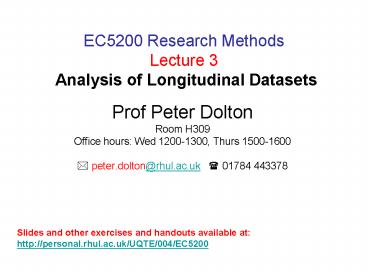EC5200 Research Methods Lecture 3 Analysis of Longitudinal Datasets - PowerPoint PPT Presentation
1 / 15
Title:
EC5200 Research Methods Lecture 3 Analysis of Longitudinal Datasets
Description:
NCDS Follow-ups. Scores scale. Reading test scale. Figure 3c. Wages scale (pounds per week) BCS70 Follow-ups. Useful Websites for Further Information ... – PowerPoint PPT presentation
Number of Views:55
Avg rating:3.0/5.0
Title: EC5200 Research Methods Lecture 3 Analysis of Longitudinal Datasets
1
EC5200 Research MethodsLecture 3 Analysis of
Longitudinal Datasets
- Prof Peter Dolton
- Room H309
- Office hours Wed 1200-1300, Thurs 1500-1600
- ? peter.dolton_at_rhul.ac.uk ? 01784 443378
Slides and other exercises and handouts available
at http//personal.rhul.ac.uk/UQTE/004/EC5200
2
References
- On data
- ESRC Data Archive
- Tracking people A Guide to Longitudinal Social
Sources, Govt Statistical Service - On LS
- Chp 8 in C Hakim (2000), Research Design 2nd
ed, Routledge - Regression
- C. Dougherty (2002) Introduction to
Econometrics Oxford UP - Panel Longitudinal Data
- Baltagi, B (2003) Econometric Analysis of Panel
Data, 2nd Ed
3
Data Types
- Cross Section different units at the same point
in time. - Time Series same unit over time
- Longitudinal same obs at different points in
time at least 2. - May involve admin data merging
- Different time intervals for different purposes.
- May involve tests of the subjects
- May involve data collection from
teachers/schools/ other organisations. - Main feature of (prospective) Longitudinal data
is that allows us to track change and development.
4
LS Types
- Panel Study Is an LS which attempts to be
nationally representative BHPS, PSID in USA - Cohort Study particular experience or
characteristic in common then follow up NCDS
born in 1958, YCS school leavers. - Intergenerational Studies PSID, NCDS and NLS
now have studied the kids of cohort members. - Retrospective Studies Collect data once asking
questions about past dates and events problem
of post-hoc rationalisation bias. - Synthetic Cohort Pseudo Panel Data
- Cross National Comparative Studies ECHP 12
countries from 1994 60,000 households 130,000
persons.
5
Problems with LS
- Big problem with LS is that of initial
non-response and attrition - There are different types of non-response
- Voluntary - refuse
- Involuntary death, imprisonment
- Non-contact move away etc
- Solutions
- Weighting
- Structural Methods
- Refreshment Sampling.
6
Problems with LS
- Often researchers apply cross section methods to
LS - Seams problem different states at overlap
points in LS - LS are often interdisciplinary tribal warfare
over questions inevitable . - Expense continuity over funding over long run
is a huge problem. - Size of data usually at least 5,000 obs over
time - Moral / ethical issues confidentiality
- Merging with admin data eg Crime data!?
- DNA problems
7
Design of LS
- Tracing issue how do you keep in touch to
minimize drop-out Birthday cards etc for NCDS. - Optimal gaps between surveys bigger gaps
mean more drop out and bigger recall issues but
more often means more expense. - Data documentation continuity is important.
this can be a big problem over the extreme long
run e.g. NCDS - Type of data collection CAPI, CATI options
- Difficult decisions on Quality /Cost
trade-off - Telephone v Face to Face.
- Merging / Sampling from admin.
8
Analysis of LS
- Analysis of LS is complex.
- Permits Duration/Event History modelling
- Multiple state and transition methods.
- Fixed Effects/ Random Effects nets out for
unobserved heterogeneity. - LS data is not experimental but it does sometimes
allow for the assessment of policy change using
Differences-in-differences those who were and
were not affected by the change. - Often having more than one cohort is very useful
e.g. graduate cohorts 60, 70, 80, 85, 90, 95.
or YCS or NCDS v BCS
9
British Birth Cohort Studies
- Previous UK/GB National Studies
- 1946 MRC National Survey of Health
Development - 1958 National Child Development Study
- 1970 1970 British Birth Cohort Study
- MCS the first national birth cohort study for
30 years 2000-1 - 1958, 1970 MCS based at IOE
British Birth Cohort Studies
10
Why cohort studies are important
- Continuing birth cohort studies are expensive
compared to cross-sectional surveys, but they are
important because - They tell the linked stories of the lives of the
members - They record how long someone occupies a given
state - They link events across the life course across
domains - They enable investigation of the cause effects
11
Periods ages of data collection in the 3 studies
12
NCDS Follow-ups
13
Figure 3c
Wages scale (pounds per week)
Scores scale
Reading test scale
14
BCS70 Follow-ups
15
Useful Websites for Further Information
- http//www.cls.ioe.ac.uk/Cohort/MCS/mcsmain.htm
- Millennium Cohort Study (MCS) Main page
- Includes Rationale, Surveys, MCS Launch, Data
Archive, Documentation, Contact details - http//www.cls.ioe.ac.uk/Cohort/MCS/Publications/m
ainpubs.htm - Annual report, Conference Papers, Journal
Articles - http//ioewebserver.ioe.ac.uk/ioe/cms/get.asp?cid
6186 - Bedford Group (BG) on the Institute of Education
(IoE) Website - http//ioewebserver.ioe.ac.uk/ioe/cms/get.asp?cid
61946194_08239 - MCS on BG/IoE Website including the MCS Users
Guide to Initial Findings (Descriptive Report)































